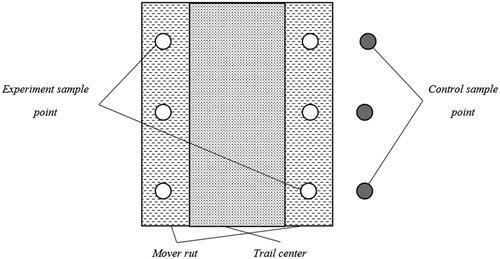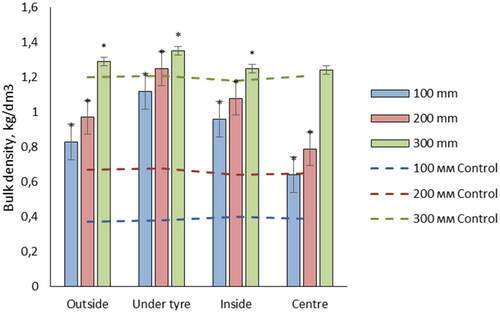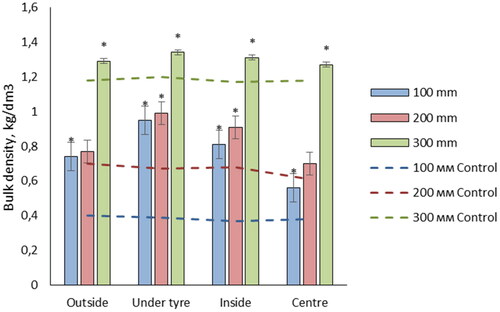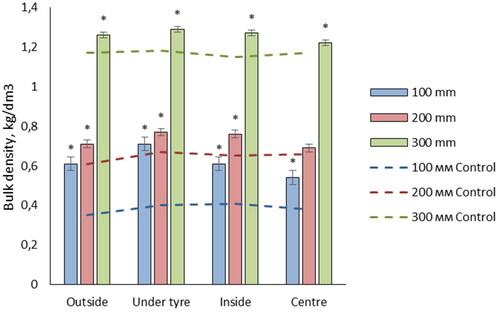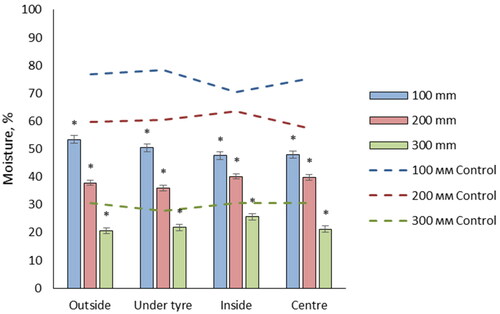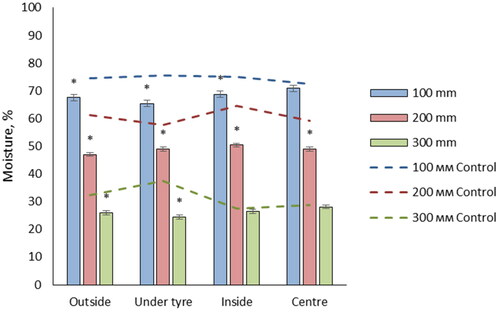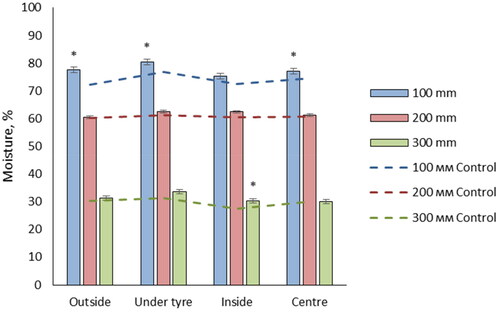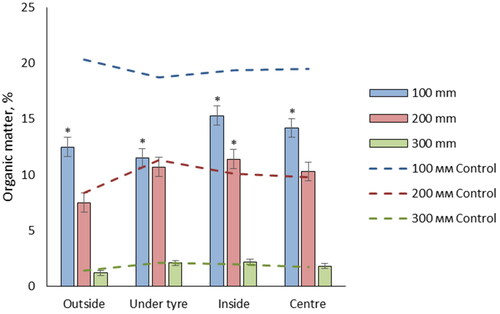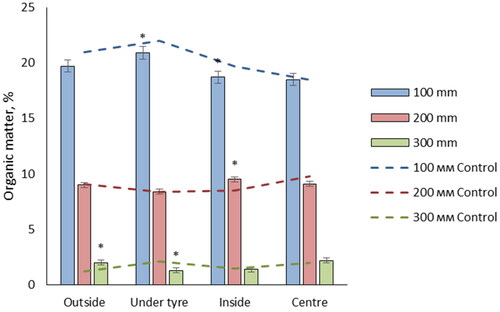Abstract
Forest resources have paramount importance for countries around the world. Among these resources, forest soils bear the brunt of the negative impact resulting from logging, especially during the transportation of wood. In this regard, the construction of temporary forest roads using soil-protective materials can become mandatory. This study involved the immediate application of shrubs and plastic mats to previously untreated trails. The study found that these methods have a less negative effect on the soil bulk density: 10.2-43.6% for shrub mats and 3.4-38.5% for plastic mats compared to the baseline values. At the same time, the density increased by 8.5-64.1% in the control area. The content of moisture and organic matter changed relative to the initial values by -14.1-0.6% and 0.1-5.2% for shrub mats. The differences were -5.2-0.0% (moisture) and -1.3-0.0% (organic matter) for plastic mats. These results demonstrated that the use of plastic mats to protect the soil from the adverse effects of logging equipment is becoming a very promising and effective strategy. This study highlights the importance of these soil protection measures to maintain the health and viability of forest ecosystems during logging.
Introduction
Abundant natural plant resources are vital for the economy and ecological welfare of many countries. Russian forests are rich in diverse resources and make a significant contribution to the wealth of the country (Pérez‐Moreno et al. Citation2021). The preservation of these forests is crucial for ecological stability in Russia (Larionov et al. Citation2021). Forest stands demonstrate natural diversity due to different conditions (Grigoreva et al. Citation2022a).
Forests play an important role that goes beyond aesthetics: forests regulate the water cycle, maintain climate stability, and preserve biodiversity (Grigoreva et al. Citation2021, Citation2022b). These areas also significantly mitigate climate change by absorbing carbon dioxide and releasing oxygen. Although the forestry industry remains the main application (Nunes et al. Citation2020), forests have a broader ecological significance.
The crucial role of forest roads in ensuring forestry activity requires careful consideration of their design and construction. Accessible and well-designed roads are essential for the efficient harvesting, transportation, conservation, restoration, and management of wildlife in forests (Grigorev et al. Citation2021). As the length of roads increases every year, it becomes necessary to solve issues related to accessibility, maintenance costs, and environmental problems (Kleinschroth et al. Citation2019). The wood transportation process, including road construction and resource planning, requires an integrated approach. This approach rests on topography, soil types, and environmental constraints (Picchio et al. Citation2018).
The growth in the size of logging equipment, such as forwarders, harvesters, and skidders, contributes to soil disturbance during forestry operations (Varol et al. Citation2020). Soil compaction, rutting, and displacement are common problems caused by heavy machinery. These problems affect root growth and hydrological runoff (Lu et al. Citation2020). In particular, skidding tractors increase soil compaction and remove forest litter (Abbas et al. Citation2018). To mitigate these problems, there is an obvious need for protective measures, including the use of suitable materials for the construction of forest roads. These measures can minimize environmental impacts and promote the long-term health of the forest ecosystem.
Forest soils vary depending on such factors as region, organic matter content, and vegetation type. This fact explains differences in compaction indicators (Olorunfemi et al. Citation2018). Effective forest management can limit soil disturbance to certain areas, such as trails. At the same time, soil compaction occurs due to various reasons (Naghdi et al. Citation2020).
Scientific studies show that the initial use of logging equipment has the greatest impact on the topsoil. Subsequent uses increase soil damage (Medvedev et al. Citation2022). Soil compaction, although harmful in many aspects, can increase fertility at a moderate level (Poltorak et al. Citation2018; Varol et al. Citation2020).
To minimize the environmental impact during logging, it is crucial to evaluate the impact of skidding equipment on soil compaction. Different tracks and lighter vehicles with larger tires can mitigate the impact on the soil (Zemánek and Neruda Citation2021). Such methods as litter and shrub mats, especially from tree tops and branches, protect the soil and reduce compaction. In addition, their disposal is an effective byproduct of the logging industry (Labelle et al. Citation2022).
The trail sections with brush mats (density from 15 to 25 kg/m2) experience less soil compaction. However, soil compaction is impossible to eliminate even when using shrub mats and shrubs (Rahman Citation2019). The effectiveness of mats for soil protection depends on such factors as composition, quantity, soil moisture, intensity of equipment use, terrain, and thickness of the soil layer (Cambi et al. Citation2015).
In addition to the remnants of logging, the construction of temporary roads can use such options as wooden mats, geosynthetic materials, and tire shields (Koerner Citation2012). A pavement system improves pavement texture. This system can potentially reduce noise, rolling resistance, and particle dispersion, improving vehicle performance (Andriejauskas et al. Citation2014). However, motor roads may encounter traction problems in adverse weather conditions. Moreover, the choice of pavement texture affects tire wear and energy efficiency (Ponniah et al. Citation2010). Given these factors, the use of protective materials is important to consider in forestry operations to minimize the impact on the environment.
Effective soil conservation methods are critical not only for the forest but also for lowering transportation costs and increasing the efficiency of forestry operations. This will benefit the forest industry and sustainable forest management. Thus, this paper aims to investigate the use of plastic mats in the construction of temporary forest roads as a means to reduce soil disturbance.
Materials and Methods
Location
The tests were conducted in the Republic of Sakha (Yakutia) forest complexes (, shown by an arrow) during the logging season of 2022 (October-November). Gleyey peat-meadow and permafrost-taiga soils predominate, the territory is hilly with average slopes of 3-6°. The yearly average temperature does not rise above -15 °C, and the annual average precipitation amount is 5-15 mm. Siberian larch (Lárix sibírica) is the primary commercially viable wood.
Field Experiment Design
A 500 m x 500 m experimental section with homogeneous gleyey soils inside was arranged. First, rectangular strips with the same terrain slope (3-5°) 400 m long and 5 m wide were chosen to serve as forest trails in the area. The trail was then split into three sections, each measuring 100 m long and spaced 50 m apart (). Due to the absence of pre-construction operations on the sections, all surface vegetation and organic debris were removed from the trails before the experiment began.
Figure 2. Experimental Forest Road Layout: a) a trail with plastic mats, b) trail spacing, c) a trail with shrub mats, d) a control trail.

ISOTRACK X plastic mats with the following characteristics were used on trail a: length: 4000 mm, width: 2000 mm, height: 102 mm; usable area: 6.84 m2; weight: 360 kg; Compressive load capacity: 415 t/m2; maximum operating load: 200 t.
There were 50 plastic mats in total. The mats were installed according to the manufacturer's instructions. Shrub mats were used on trail b, using branches of 10–60 mm in diameter and 1000–3000 mm in length obtained in advance during forestry operations. The applied mats tightly covered the area of the research with a density of 10 kg/m2 and protected the soil from the negative effects of technical equipment. The total weight of shrub mats was 5 tonnes. No additional methods were used on trail c. It should also be noted that the other sections received no preliminary soil preparation.
Sampling
Before the experiment, 20 mm diameter, 400 mm deep holes were drilled perpendicular to the forest floor using a drill screw (). Six samples were collected at depths of 0 and 400 mm. The samples collected at the experiment sections before the tests were conducted were used as control values, with the values for all the studied parameters being averaged over the entire section. All soil samples were taken at the same time to exclude the influence of daily or seasonal changes after the conduct of logging operations. Thus, the control values referred to soil not disturbed by forest operations. A total of 51 samples were collected (4 samples × 3 trails × 3 times after the experiment and 5 samples × 3 trails for the control values).
Analytical indicators
Soil moisture, bulk density, and organic matter content were all measured during the experiment. The moisture content of the soil was calculated as the difference in mass between wet and dry soil (after drying to a constant mass at 60 °C). Bulk density was taken as the mass of dry soil per unit volume of wet soil (Poltorak et al. Citation2018). The organic matter concentration was measured as follows. First, 1 g of dried soil was dispersed in 5 cm3 sodium polytungstate (concentration of 1.85 g/cm3). The light fraction was then separated, and the heavy fraction was washed from the dispersant and sieved through a 53 µm sieve. Centrifugation was used to separate the clay fraction, which was then dried at 60 °C to a constant mass and analysed using isotope ratio mass spectrometry (Soong and Cotrufo Citation2015).
Vehicle parameters
The study used a PONSSE Buffalo forwarder with the following parameters: type – wheeled; engine – 205 kW diesel; maximum speed – 20 km/h; weight – 21,100 kg; lifting capacity – 18,000 kg; dimensions – width 3300 mm, length 10,860 mm, height 3910 mm, road clearance 730 mm.
Data analysis
The mean value of three samples for each depth and parameter was used to calculate all data. A one-way ANOVA test with a significance level of α = 0.05 was used for statistical analysis. Microsoft Excel (2013) was used to obtain graphical data.
Results and Discussion
The soil dry bulk density before tests was 0.35–1.21 kg/dm3. Meanwhile, as depth increased, the density increased by 70% (relative). The dry bulk density was 0.39 ± 0.02 kg/dm3 at a 100 mm depth, 0.66 ± 0.03 kg/dm3 at a 200 mm depth, and 1.18 ± 0.02 kg/dm3 at a 300 mm depth. The values of bulk den three samples sity were shown on .
The application of plastic mats yielded the following results (). As in previous cases, samples at a 100 mm depth yielded the lowest values (0.54–0.71 kg/dm3). However, at greater depths, the effect was less pronounced. Thus, the density at 200 mm was 0.69–0.77 kg/dm3, while at 300 mm, it was 1.22–1.29 kg/dm3, or 5–17% and 4–10%, respectively. When evaluating the results based on the sampling points’ location, it should be noted that the values were higher at the points closest to the wheel contact. On the surface with plastic mats, there was a decrease in the soil bulk density at a depth of 100 mm in comparison with the control. This fact indicates that mats reduce soil compression under the influence of external loads, such as tractor traffic. However, at greater depths (200 mm and 300 mm), the effect of this decrease in bulk density was less significant.
Using a shrub mat resulted in less soil compaction (). The values followed a similar pattern. Thus, the bulk density at a 100 mm depth was 0.56–0.95 kg/dm3. The average density increased by 0.13 kg/dm3 (or 10–34%) relative to the control value and was 0.84 ± 0.13 kg/dm3 when measured at 200 mm depth. However, when measured at a 300 mm depth, it was 1.30 ± 0.03 kg/dm3, which was only 8–12% higher than the control value. Similar to the previous instance, the highest compaction values (in average 47–144%) were found at the forwarder's passage points. It should be noted that soil compaction outside the passage and in the centre remained statistically constant compared to the control value. The effect of reducing the compaction is most significant at equipment passage points. On these points, shrub mats effectively amortise the impact of mechanized equipment. It is important to note that statistically constant compaction remains outside the passage area and in the centre. This fact indicates the localised impact of mats.
The road section with no additional protection measures showed the most changes (). The values at the minimum soil depth ranged between 0.64 and 1.12 kg/dm3. With a 100 mm increase in depth, the density was approximately 116% of the previous value (1.02 ± 0.19 kg/dm3); at a 300 mm depth, the density was even 28% higher (1.28 ± 0.05 kg/dm3). Analysing the sampling location, it can be seen that compaction was greatest at the tyre passages, while values changed the least in the central or so-called ‘buffer zone’. At the same time, no statistically distinguishable data were observed at the maximum depth. The greatest density change (in average +194%) was observed at the wheel contact points in the upper soil layers. Furthermore, the values were highest at all depths at these points. With increasing depth, the effect on the soil decreased in average: 64–94% at 100 mm, 21.5–83.8% at 200 mm, and 2.5–11.6% at 300 mm.
show the results of the soil moisture analysis. The exact opposite was observed in the section where plastic mats were applied ().
When the plastic mats were used, the soil moisture values increased at all points compared to the control values. The lowest depth (100 mm) showed the biggest difference from the control values. Thus, the values were 77.6 ± 2.1%, whereas the moisture content in this section was 74.0 ± 2.1% before the use of mats. Moisture (control value) decreased with increasing depth to 60.6 ± 0.4% and 29.8 ± 1.5% at 200 mm and 300 mm, respectively, whereas it was 61.7 ± 0.9% and 31.4 ± 1.5% during the experiment. The use of plastic mats increases soil moisture. At a depth of 100 mm, where the mats have the greatest impact, there was a significant increase in humidity compared to the control. The reason may be the improved moisture-retaining properties of the soil under the influence of mats.
The amount of moisture was significantly higher after using shrub mats (). For example, at a 100 mm depth, the average moisture content was 68.1%, only 6.3% less than the control value. At the same time, the difference between the values at 200 mm depth increased to 9–14%, whereas it was only 1–13% at a 300 mm depth. Such variations can be attributed to differences in soil permeability at different depths caused by topographic differences. Shrub mats significantly increase soil moisture after their application. This effect is especially noticeable on the surface (depth of 100 mm) and creates favourable conditions for vegetation. Variations in moisture content at different depths may be due to differences in soil permeability at different depths caused by topographic features.
Soil moisture values at a 100 mm depth were 53.4%, 50.4%, 47.6%, and 48.0% for points located to the right, under the wheel, to the left, and to the centre of the section, respectively (). When compared to the control values (76.8%, 78.4%, 70.5%, 75.4%), there was a decrease in moisture content when the forwarder passed over an unprotected site. The difference between the control and tested values decreased with depth to 5–10% (at 300 mm) and 18–24%.
The impact of forwarder timber transport on organic matter content was also studied. show the results of this experiment.
The organic matter content of the soil in the plastic mat section was mostly increased. Thus, the amount was 18.5–22.0% at a 100 mm depth and 18.5–20.9% after the experiment. Nevertheless, positive changes to a maximum of + 1% were seen at greater depths.
A shrub mat () allowed for greater organic matter retention. However, no positive effects were found. The concentration was not less than 15% at the minimum soil depth, whereas the control values were 19.7–21.5%. The value difference decreased as soil depth increased (1–2% at a 200 mm depth and 0.1–0.4% at a 300 mm depth).
As can be seen from , the forwarder's passage harmed the organic content, particularly in the upper layers. The difference between the control and experimental values was 4-8% (at a 100 mm depth). In the lower soil layers (200 mm and 300 mm), there was either an increase or no statistically significant differences: 8.4–9.8% for the control and 7.5–11.4% for experimental values at a 200 mm depth; 1.2–2.1% (control) and 1.2–2.1% (experimental) at a 300 mm depth.
The results of our study suggest that the bulk density of dry soil largely depends on several factors. At the initial stage of the study, the study revealed a wide variation of values ranging from 0.35 to 1.21 kg/dm3. This variability can be due to the changes in soil properties at different depths and the location of the measurement points.
However, the most interesting result was the discovery that the density of dry soil increases with increasing depth by 70%. This observation highlights the importance of depth in the process of assessing the impact of temporary forest roads on the soil. In addition, it is important to note that vehicles moving on a road section without additional protection measures caused significant changes in soil density. Consequently, this section demonstrated the most pronounced changes. This fact indicates the need to apply measures to mitigate the impact and protect soil.
Regarding soil moisture, observations showed that the equipment moving without protective measures reduced soil moisture at different depths. However, shrub and plastic mats maintained or even increased moisture levels, especially at shallow depths. As for the content of organic matter in the soil, technical equipment affected it, especially in the upper layers. The shrub mats and plastic mats helped to maintain this content but without significant positive changes.
Using forestry machinery causes compaction of the soil's fertile layer, a decrease in moisture, and a decrease in organic matter. Venanzi et al. (Citation2016) discovered that soil exposure reduced organic matter content by about 6%. Mechanical transport causes soil disturbance, after which organic matter can be transported further on wheels. Furthermore, the microbiocenosis, which accounts for most organic matter, may be disturbed during transport. When the concentration of carbon dioxide increases to the acidic side, the soil's acidity also changes. This pH level can harm both vegetation and soil microorganisms (Alekseenko et al. Citation2022). Lee et al. (Citation2020) investigated the impact of transportation on soil's physical properties. The authors discovered, similarly to the present paper, that the bulk density increased with increasing depth. The values ranged from 1.26 ± 0.03 g/cm3 to 1.35 ± 0.05 g/cm3 at depths of up to 10 cm and 20 cm, respectively. However, the density was 2–3 times lower in the present study due to the use of a different type of soil (Lee et al. Citation2020).
A study conducted by Poltorak et al. (Citation2018) is most comparable to the present one. They used shrub mats ranging in density from 5 to 20 kg/m2. It was discovered that increasing the number of branches positively affected the soil's resistance to rutting, soil displacement, and other characteristics (Poltorak et al. Citation2018). Labelle et al. (Citation2019) found that soil moisture decreased in the lower soil layers, consistent with the present findings. Furthermore, the bulk density of the soil increased with depth, but the use of shrub mats, as in the present study (Labelle et al. Citation2019), reduced these characteristics.
Our study provides valuable information about the impact of various soil protection measures in the construction of forest roads. By analyzing changes in soil density, moisture, and organic matter content, the research sheds light on how these measures can mitigate the negative impact on soil quality. One of the most important aspects is the practical applicability of our results. The construction of forest roads is commonplace in many regions, and its impact on soil health and the surrounding ecosystem is impossible to ignore. The study shows that shrub and plastic mats can minimize this impact.
However, it is crucial to recognize that each forest ecosystem is unique. Consequently, the choice of soil protection measures should depend on the context. Thus, our study serves as a valuable addition to the existing body of knowledge, providing forest managers and practitioners with valuable data-based information.
Conclusions
The study investigated two methods of protecting the fertile soil layer in logging: shrub mats and plastic mats. Both methods effectively reduce soil damage. For example, shrub mats decreased soil density at various depths, and it was a significant percentage of the control values. Plastic mats also successfully reduced the soil density, keeping soil moisture at higher levels compared to shrub mats.
Thus, plastic mats are a more effective soil protection method than shrub mats. Therefore, their application must be studied in greater depth, including other soil characteristics and using more machinery. The results of this experiment provide valuable information about soil protection strategies during forestry operations. By demonstrating the effectiveness of plastic mats, this study highlights the potential for wider adoption of this method in forestry practice. However, it is important to realize that the applicability of soil protection measures may vary depending on specific soil types, forest ecosystems, and operating conditions.
Acknowledgments
The study was carried out within the confines of the scientific school advances in lumber industry and forestry. The underlying content of this paper was supported by the grant of the Russian science foundation no. 23-16-00092, https://rscf.ru/project/23-16-00092/.
Data availability statement
Data will be available on request.
Competing interests
There are no competing interests to declare.
References
- Abbas D, Di Fulvio F, Spinelli R. 2018. European and United States perspectives on forest operations in environmentally sensitive areas. Scand J For Res 33(2):188–201. doi: 10.1080/02827581.2017.1338355.
- Alekseenko AV, Drebenstedt C, Bech J. 2022. Assessment and abatement of the eco-risk caused by mine spoils in the dry subtropical climate. Environ Geochem Health 44(5):1581–1603. doi: 10.1007/s10653-021-00885-3.
- Andriejauskas T, Vorobjovas V, Mielonas V. 2014. Evaluation of skid resistance characteristics and measurement methods. In: Environmental Engineering. In: Proceedings of the International Conference on Environmental Engineering. ICEE. Vol. 9. Vilnius Gediminas Technical University, Department of Construction Economics & Property; p. 1–8. doi: 10.3846/enviro.2014.141.
- Cambi M, Certini G, Neri F, Marchi E. 2015. The impact of heavy traffic on forest soils: A review. For Ecol Manag 338:124–138. doi: 10.1016/j.foreco.2014.11.022.
- Grigorev GV, Dmitrieva IN, Grigorev IV, Kalyashov VA, Rudov SE, Ivanov VA. 2021. Problems and prospects of timber production in conditions of permafrost distribution areas. Syst Meth Technol 3:59–67. doi: 10.18324/2077-5415-2021-3-59-67.
- Grigoreva O, Runova E, Savchenkova V, Hertz E, Voronova A, Ivanov V, Lavrov M. 2021. Comparative analysis of thinning techniques in pine forests. J For Res 33(4):1145–1156. doi: 10.1007/s11676-021-01415-8.
- Grigoreva O, Runova E, Tikhonov E, Storodubtseva T, Druzyanova V, Hertz EF, Grigorev I. 2022a. Dynamics of the taxation characteristics of forest stands in the north-west of Russia. Pol J Environ Stud 31(5):4107–4115. doi: 10.15244/pjoes/147588.
- Grigoreva OI, Bogachev PV, Panarin AO. 2022b. Assessment of the forest structure for thinning and increment felling operations when transitioning to intensive forestry model regulations. In: Russian Forests: Policy, Industry, Science, Education. Saint-Petersburg, Russia; p. 125–126.
- Kleinschroth F, Laporte N, Laurance WF, Goetz SJ, Ghazoul J. 2019. Road expansion and persistence in forests of the Congo Basin. Nat Sustainability 2(7):628–634. doi: 10.1038/s41893-019-0310-6.
- Koerner RM. 2012. Designing with geosynthetics. Vol. 1. Bloomington: Xlibris Corporation.
- Labelle ER, Hansson L, Högbom L, Jourgholami M, Laschi A. 2022. Strategies to mitigate the effects of soil physical disturbances caused by forest machinery: A comprehensive review. Curr For Rep 8(1):20–37. doi: 10.1007/s40725-021-00155-6.
- Labelle ER, Poltorak BJ, Jaeger D. 2019. The role of brush mats in mitigating machine-induced soil disturbances: an assessment using absolute and relative soil bulk density and penetration resistance. Canad J For Res 49(2):164–178. doi: 10.1139/cjfr-2018-0324.
- Larionov MV, Dogadina MA, Tarakin V, Minakova IV, Sentishcheva EA, Bukreeva TN. 2021. Creation of artificial phytocenoses with controlled properties as a tool for managing cultural ecosystems and landscapes. In: IOP Conference Series: Earth and Environmental Science. Vol. 848, No. 1. New York: IOP Publishing; p. 012127. doi: 10.1088/1755-1315/848/1/012127.
- Lee E, Li Q, Eu S, Han SK, Im S. 2020. Assessing the impacts of log extraction by typical small shovel logging system on soil physical and hydrological properties in the Republic of Korea. Heliyon 6(3):e03544. doi: 10.1016/j.heliyon.2020.e03544.
- Lu J, Zhang Q, Werner AD, Li Y, Jiang S, Tan Z. 2020. Root-induced changes of soil hydraulic properties–A review. J Hydr 589:125203. doi: 10.1016/j.jhydrol.2020.125203.
- Medvedev S, Zyryanov M, Mokhirev A, Kunickaya O, Voronov R, Storodubtseva T, Grigoreva O, Grigorev I. 2022. Russian timber industry: Current situation and modelling of prospects for wood biomass use. Int J Design Nature Ecodyn 17(5):745–752. doi: 10.18280/ijdne.170512.
- Naghdi R, Solgi A, Labelle ER, Nikooy M. 2020. Combined effects of soil texture and machine operating trail gradient on changes in forest soil physical properties during ground-based skidding. Pedosphere 30(4):508–516. doi: 10.1016/s1002-0160(17)60428-4.
- Nunes LJ, Meireles CI, Pinto Gomes CJ, Almeida Ribeiro NM. 2020. Forest contribution to climate change mitigation: Management oriented to carbon capture and storage. Climate 8(2):21. doi: 10.3390/cli8020021.
- Olorunfemi IE, Fasinmirin JT, Akinola FF. 2018. Soil physico-chemical properties and fertility status of long-term land use and cover changes: A case study in forest vegetative zone of Nigeria. Eur J Soil Sci 7(2):133–150. doi: 10.18393/ejss.366168.
- Pérez‐Moreno J, Guerin‐Laguette A, Rinaldi AC, Yu F, Verbeken A, Hernández‐Santiago F, Martínez‐Reyes M. 2021. Edible mycorrhizal fungi of the world: What is their role in forest sustainability, food security, biocultural conservation and climate change? Plants People Planet 3(5):471–490. doi: 10.1002/ppp3.10199.
- Picchio R, Pignatti G, Marchi E, Latterini F, Benanchi M, Foderi C, Verani S. 2018. The application of two approaches using GIS technology implementation in forest road network planning in an Italian mountain setting. Forests 9(5):277. doi: 10.3390/f9050277.
- Poltorak BJ, Labelle ER, Jaeger D. 2018. Soil displacement during ground-based mechanised forest operations using mixed-wood brush mats. Soil Tillage Res 179:96–104. doi: 10.1016/j.still.2018.02.005.
- Ponniah J, Tabib S, Lane B, Raymond C. 2010. Evaluation of the effectiveness of different mix types to reduce noise level at the tire/pavement interface. In: Proceedings of the Annual Conference of the Transportation Association of Canada. Nova Scotia, Canada: Halifax; p. 1–20.
- Rahman R. 2019. Assessing Soil Compaction Following a Winter Timber Harvest in the Western Upper Peninsula of Michigan [doctoral dissertation]. MI: Michigan Technological University.
- Soong JL, Cotrufo MF. 2015. Annual burning of a tallgrass prairie inhibits C and N cycling in soil, increasing recalcitrant pyrogenic organic matter storage while reducing N availability. Glob Chang Biol. 21(6):2321–2333. doi: 10.1111/gcb.12832.
- Varol T, Emir T, Akgul M, Ozel HB, Acar HH, Cetin M. 2020. Impacts of small-scale mechanised logging equipment on soil compaction in forests. J Soil Sci Plant Nutr 20:953–963. doi: 10.1007/s42729-020-00182-5.
- Venanzi R, Picchio R, Piovesan G. 2016. Silvicultural and logging impact on soil characteristics in Chestnut (Castanea sativa Mill.) Mediterranean coppice. Ecol Engin 92:82–89. doi: 10.1016/j.ecoleng.2016.03.034.
- Zemánek T, Neruda J. 2021. Impact on the operation of a forwarder with the wheeled, tracked-wheel or tracked chassis on the soil surface. Forests 12(3):336. doi: 10.3390/f12030336.


